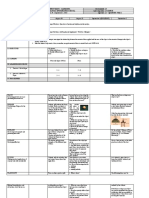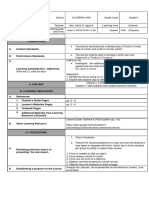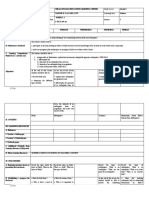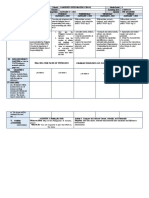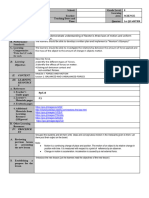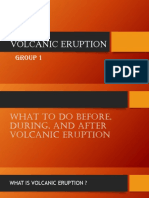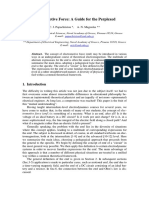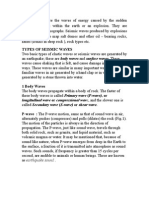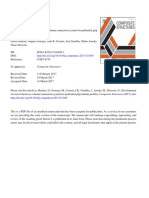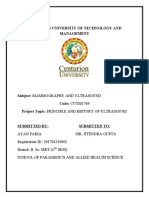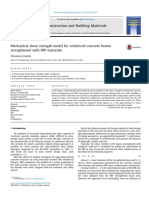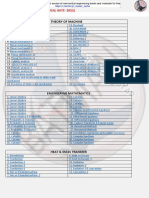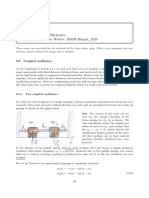Daily Lesson Log Grade 8 1.A
Daily Lesson Log Grade 8 1.A
Uploaded by
Raymund AlilingCopyright:
Available Formats
Daily Lesson Log Grade 8 1.A
Daily Lesson Log Grade 8 1.A
Uploaded by
Raymund AlilingOriginal Description:
Copyright
Available Formats
Share this document
Did you find this document useful?
Is this content inappropriate?
Copyright:
Available Formats
Daily Lesson Log Grade 8 1.A
Daily Lesson Log Grade 8 1.A
Uploaded by
Raymund AlilingCopyright:
Available Formats
Republic of the Philippines
Department of Education
DAILY LESSON LOG (1st Quarter)
Teacher Learning Area Science
Teaching Dates Grade Level 8
Time
Section
I-OBJECTIVES
Content Standard: B. Performance Standard: Learning Competency/ies:
The learners demonstrate The learners should be able to develop a written (S8FE-Ia-15)
understanding of Newton’s three plan and implement a “Newton’s Olympics” The learners should be able to investigate
laws of motion and uniform the relationship between the amount of
circular motion. force applied and the mass of the object
to the amount of change in objects
motion.
Objectives:
1.Describe force.
2.Identify the different types of forces.
3.Identify the effects of forces on matter.
4.Distinguish between contact and
non-contact forces.
II-CONTENT Module I: FORCES AND MOTION
Lesson 1: BALANCED AND UNBALANCED FORCES
III- LEARNING RESOURCES
A. References
1. Teacher’s Guide Page/s : pp. 5 - 8
2. Learner’s Materials Pages : pp. 3
3. Textbook Pages:
4. Additional Materials from learning Resources(LR) portals:
B. Other Learning Resources https://goo.gl/images/oJnWpF
http://newtonowledge.weebly.com/newtons-first-law.html
https://goo.gl/images/1VDEvF
https://goo.gl/images/7TBmWe
https://goo.gl/images/GzNs8m
https://goo.gl/images/dgQTU2
IV- PROCEDURES
A. Reviewing previous lesson or presenting the Grouped the students and let them write ideas and concept about motion in the metacards
new lesson given to them. Let them post their output on the board.
Note:
Motion is a continuing change of place and position .The motion of an object is its
relative change in position with time. It is measured with respect to a point of
reference by an observer.
Change in motion is acceleration. Acceleration is caused by a net external force.
B. Establishing a purpose for the lesson -Introduce the new lesson (Let the learners read the objectives of the new lesson)
C. Presenting illustrative examples/instances of The teacher will place a ball or any object on top of a table and ask:
the lesson
a) Will this object move by itself?
b) How can we make this object move?
c) While it is moving, how can we make the object speed up or slow down?
d) How can make it stop?
e) How can we make it change its direction?
D. Discussing the new concepts and practicing Group the students and let them examine and analyze the pictures and tell something about
new skills#1 force.
( Group Activity Rubrics will be presented and revive by the students.)
1. Do you think they can move
1.
1. Do you think the foot can move
the ball?
2. Why you said so?
3. What causes the ball to move?
4. Does the picture shows contact
force? Noncontact force? Explain
2.
1. Do you think the elbow can move
the takyan?
2. Why you said so?
3. What causes the ball to move?
4. Does the picture shows contact
force? Noncontact force? Explain
3.
1. Do you think the cue ball can move
the balls?
2. Why you said so?
3. What causes the ball to move?
4. Does the picture shows contact
4. force? Noncontact force? Explain
Note:
A Force is commonly describe as the push and the pull which can set an object in
motion, speed it up or slow it down,or may even change direction of its motion.
A force acts on an object.A push and a pull on something-an object. Forces do not exist
in isolation from the object that experiences them.
A force has an agent-a specific identifiable cause.
A force is a vector quantity. If you push an object,you can push it either gently or very
hard. Similarly, you can push either left or right, up and down. To quantify push ,we
need to specify both magnitude and direction.
E. Discussing new concepts and new skills #2 Discuss force and its types.
There are four fundamental forces:
1.Gravitational Force- force attraction between two masses…such as the position of the stars
and the planet in the solar system
2.Electromagnetic Force- force that affect the charge particles…such as The electrons from the
clouds will travel towards the land –thunderbolts and the attraction between your hair and the
charge balloon.
3. Weak Force- the radioactive decay
4. Strong nuclear Force-binds protons and neutrons in the nucleus of an atom.
The types of forces are:
1. tension force- the contact force exerted by a string or a wire which pulls an object.
2. normal force- force exerted by a surface (the agent) against an object that is pressing against
the surface
3. tensional force- the force that is transmitted through a rope, string or wire when pulled by
forces acting from opposite sides.
A force can either be contact or non-contact force. A contact force is present in surfaces in
contact with each othersuch as frictional force while non-contact force acts on bodies with
greater distances such as gravitational force, magnetic force and nuclear force.
The students can be provided a copy of figures below.
F. Developing mastery(guides formative A.Answer the following question
assessment) 1.What is force?
(a force is a push and a pull on an object)
2.What can a force do on an object?
(A force can make things move, stop, change state, change shape and change direction)
3.What are the four fundamental forces?
(the four fundamental forces are gravitational force, electromagnetic force, weak force and
strong nuclear force)
4.What are the types of forces?
(the types of forces are the tension force, normal force and frictional force)
5.How can you differentiate contact and non-contact force?
(a contact force is present in surfaces in contact with each other while non-contact force acts on
bodies with greater distances)
B. Present the following statement in class and ask the students if they agree or disagree with
them. Justify or explain their answer.
1. Force is needed to stop an object.
2. Force always results to motion.
3. Force can act even at a distance.
4. Objects have the tendency to remain at rest.
5. Objects have the tendency to resist change.
G. Making generalizations and abstractions Ask the student what they have learn in the lesson.
about the lesson What is force?
1. Force is a push or a pull.
2. Force can act on an object.
3. Force requires an agent
4. Force is a vector
What are the four fundamental forces:
1.Gravitational Force- force attraction between two masses…such as the position of the stars
and the planet in the solar system
2.Electromagnetic Force- force that affect the charge particles…such as The electrons from the
clouds will travel towards the land –thunderbolts and the attraction between your hair and the
charge balloon.
3. Weak Force- the radioactive decay
4. Strong nuclear Force-binds protons and neutrons in the nucleus of an atom.
What are types of forces base on their agents are:
1. tension force- the contact force exerted by a string or a wire which pulls an object.
2. normal force- force exerted by a surface (the agent) against an object that is pressing against
the surface
3. tensional force- the force that is transmitted through a rope, string or wire when pulled by
forces acting from opposite sides.
What is the difference between contact and noncontact force?
A force can either be contact or non-contact force. A contact force is present in surfaces in
contact with each other such as frictional force while non-contact force acts on bodies with
greater distances such as gravitational force, magnetic force and nuclear force.
What can a force do on matter?
Force can make things move, stop, change state, change shape and change direction
H. Finding Practical applications of concepts Say: Now that you have learned that force can make things move, stop, change state, shape
and skills in daily living and direction. Can you give example where force had affected you and what kind of force is it?
I. Evaluation of Learning 1.Which best describes the effect of force on the motion of an object?
A. Force causes the object to change shape or mass.
B. Force causes the object to change speed or direction.
C. Force causes the object to experience gravity.
D. Force causes the object to experience balance.
2.A push and pull on an object is ___.
A. Weight
B. Force
C. friction
D. Matter
3. A force that acts where two objects touch
A. Contact Force
B. Non-contact Force
C. Balanced Force
D. Unbalanced Force
4. What is a force that opposes motion between objects that are in contact??
A. velocity
B. direction
C. friction
D. speed
J. Additional activities for application or
remediation
Study the pictures above.
1.What kind of force is shown contact or noncontact?
2. Make an arrow on the forces acting on the object?
V. REMARKS
VI. REFLECTION
A. No. of learners who earned B. No. of learners who scored C. Did the remedial lessons D. No. of learners who continue
80% in the evaluation: ________ below 80% who needs additional work?sNo. of learners who have to require remediation:
activities for remediation: _______ caught up with the lesson: ______ _________
E. Which of my teaching strategy/ies worked well? Why did these work?
F. What difficulties did I encounter with my principal or superior can help me solve?
G. What innovation or localized materials did I Use or discover which I wish to share with other teachers?
Date: ______________ Checked by: ____________________________________
You might also like
- Daily Lesson Log Grade 8 2aDocument3 pagesDaily Lesson Log Grade 8 2aRaymund Aliling100% (2)
- Daily Lesson Log Grade 8 2aDocument3 pagesDaily Lesson Log Grade 8 2aRaymund Aliling100% (2)
- (Space Technology Library 33) F. Landis Markley, John L. Crassidis (Auth.) - Fundamentals of Spacecraft Attitude Determination and Control-Springer-Verlag New York (2014) PDFDocument495 pages(Space Technology Library 33) F. Landis Markley, John L. Crassidis (Auth.) - Fundamentals of Spacecraft Attitude Determination and Control-Springer-Verlag New York (2014) PDFSherlock HolmesNo ratings yet
- Demo Lesson Plan AccelerationDocument4 pagesDemo Lesson Plan Accelerationmarizel ortega100% (1)
- Daily Lesson Log Grade 8 3bDocument2 pagesDaily Lesson Log Grade 8 3bRaymund Aliling100% (3)
- DLL Grade 8 Science First DoneDocument95 pagesDLL Grade 8 Science First Donejoan marie Pelias100% (3)
- Instructional Lesson Plan in Science 8Document4 pagesInstructional Lesson Plan in Science 8ESTHER MAE ANN TRUGILLO100% (1)
- DLP August 19,2019Document2 pagesDLP August 19,2019Shane Catherine Besares100% (1)
- Endogenic ProcessesDocument33 pagesEndogenic ProcessesRaymund Aliling100% (1)
- Detailed Science Lesson Plan 1Document2 pagesDetailed Science Lesson Plan 1Lorraine DonioNo ratings yet
- DLL Science 8Document5 pagesDLL Science 8marichuNo ratings yet
- Science LESSON PLAN - Week 1Document4 pagesScience LESSON PLAN - Week 1Kathryn Decena CentinalesNo ratings yet
- DLP Science g8Document3 pagesDLP Science g8Krizzia Lovely Perez100% (1)
- DLL Science g8-q1-w1 (Ok)Document3 pagesDLL Science g8-q1-w1 (Ok)Rosy Apple100% (1)
- Lesson 1. What Is Force& MotionDocument107 pagesLesson 1. What Is Force& MotionSalve Gregorio AguirreNo ratings yet
- DLL Science 8 Week2Document95 pagesDLL Science 8 Week2Felyn DelaCruz - DalinoNo ratings yet
- Sci 8. DLL. Q1. W1 2Document6 pagesSci 8. DLL. Q1. W1 2Marilou Cambronero SalazarNo ratings yet
- Republic of The Philippines: Department of Education Region IIIDocument3 pagesRepublic of The Philippines: Department of Education Region IIIMichaelAbdonDomingoFavoNo ratings yet
- Force and Motion - Balance and Unbalance ForcesDocument5 pagesForce and Motion - Balance and Unbalance ForcesJoanna Marie A. GripoNo ratings yet
- RTOT Force, Mtion and Energy Group 4a Ntot 2018 - 2Document6 pagesRTOT Force, Mtion and Energy Group 4a Ntot 2018 - 2Daphnie Serate NunezNo ratings yet
- Division of Bohol Science 8 Quarter 1 - Week 3 (Day 1) : S8FE-Ia-16)Document4 pagesDivision of Bohol Science 8 Quarter 1 - Week 3 (Day 1) : S8FE-Ia-16)Johndion A. RulomaNo ratings yet
- DLL History of The Periodic TableDocument14 pagesDLL History of The Periodic TableJann Kim MedenillaNo ratings yet
- Activity No. 2 Combining Forces: Net N GDocument2 pagesActivity No. 2 Combining Forces: Net N GRachel B. Inting50% (2)
- Science 8 Q1 Idea Le Melc3Document2 pagesScience 8 Q1 Idea Le Melc3Roxanne NortezNo ratings yet
- Detailed Lesson Plan in Physics Grade 8Document5 pagesDetailed Lesson Plan in Physics Grade 8Bon PatiñoNo ratings yet
- Lesson 2 Balanced and Unbalanced ForceDocument5 pagesLesson 2 Balanced and Unbalanced ForceSedwell SentNo ratings yet
- DLP Sci8 W5-3Document3 pagesDLP Sci8 W5-3Vanessa Joy SaavedraNo ratings yet
- G8-Science-Daily Lesson Log DLL TemplateDocument3 pagesG8-Science-Daily Lesson Log DLL TemplateDewson Pacudz100% (1)
- DLP Law of InertiaDocument5 pagesDLP Law of InertiaJULIE ANN PAJENo ratings yet
- G8-Fidelity 1Document4 pagesG8-Fidelity 1Emma T Sogo-anNo ratings yet
- Science 8 3rd April 5-9, 2021: Learning Area Grade Level Quarter DateDocument2 pagesScience 8 3rd April 5-9, 2021: Learning Area Grade Level Quarter DateCriselAlamag100% (2)
- LP - Science 8 - Balanced & Unbalanced ForcesDocument5 pagesLP - Science 8 - Balanced & Unbalanced ForcesDominique Louise SolisNo ratings yet
- Lesson Plan in Science Grade 8: Schools Division of Aurora Puangi National High SchoolDocument2 pagesLesson Plan in Science Grade 8: Schools Division of Aurora Puangi National High SchoolFernando AbuanNo ratings yet
- Science8 q1 Wk2Document5 pagesScience8 q1 Wk2Lenie MateoNo ratings yet
- Science 8 q1 w3Document12 pagesScience 8 q1 w3Je-ann AcuNo ratings yet
- Daily Lesson Plan For Grade 8 Science (CHEMISTRY 8)Document4 pagesDaily Lesson Plan For Grade 8 Science (CHEMISTRY 8)Ma. Socorro Hilario100% (2)
- LP 3rd LawDocument5 pagesLP 3rd LawRoan Joy BalbalosaNo ratings yet
- Daily Lesson Log: S8Es-Iia-14 S8Es-Iia-14 S8Es-Iia-14 S8Es-Iia-14Document33 pagesDaily Lesson Log: S8Es-Iia-14 S8Es-Iia-14 S8Es-Iia-14 S8Es-Iia-14SALVACION DURANNo ratings yet
- Science 8 DLL Q1 Week 3Document4 pagesScience 8 DLL Q1 Week 3Jun De FontanozaNo ratings yet
- Regional Training of Teachers On The Critical Content of Science Grade 8Document4 pagesRegional Training of Teachers On The Critical Content of Science Grade 8JADE L. SORZANO100% (1)
- Third Law DLLDocument2 pagesThird Law DLLGerlie VelascoNo ratings yet
- Grade 8 Quarter 3 - DLLDocument39 pagesGrade 8 Quarter 3 - DLLDhangManongas-LlaboreVete100% (2)
- DLP Science 8 Wk1D2 2nd QTRDocument2 pagesDLP Science 8 Wk1D2 2nd QTRLianne Marie CabanginNo ratings yet
- I. Objectives: Detailed Lesson Plan in Integrated Science 8Document17 pagesI. Objectives: Detailed Lesson Plan in Integrated Science 8Janet PagulayanNo ratings yet
- Science 8 DLLDocument9 pagesScience 8 DLLLovie Alfonso0% (1)
- DLL SCI8 - Sept 23-27Document5 pagesDLL SCI8 - Sept 23-27jeff autor0% (1)
- DLL For Cot 1Document9 pagesDLL For Cot 1AVEGAY CELISNo ratings yet
- DLL - Science 8 - Q2Document17 pagesDLL - Science 8 - Q2Nazer M. Lacabo100% (3)
- BoW - Science 8Document6 pagesBoW - Science 8John EviotaNo ratings yet
- DLLDocument3 pagesDLLNoresa Dacula Engcong - AbasNo ratings yet
- DLL Demo2 ZAPENDocument4 pagesDLL Demo2 ZAPENHomemade BarquillosNo ratings yet
- DLL-Science 8Document2 pagesDLL-Science 8GERRY CHEL LAURENTE100% (2)
- Pagdato Cot Digestive-SystemDocument9 pagesPagdato Cot Digestive-SystemDave Joshua BrownNo ratings yet
- Daily Lesson Plan: Ramon Avanceña National High SchoolDocument2 pagesDaily Lesson Plan: Ramon Avanceña National High SchoolShane Catherine BesaresNo ratings yet
- Lesson Guide G8 Q2 Part 1Document21 pagesLesson Guide G8 Q2 Part 1Lauro Albano Jr.100% (1)
- Science 8 Quarter 2 Week 3Document3 pagesScience 8 Quarter 2 Week 3Black Venus100% (2)
- Daily Lesson Log: Laptop, ProjectorDocument5 pagesDaily Lesson Log: Laptop, ProjectorFabio Jr CapitoNo ratings yet
- DLP For COT Round 3Document7 pagesDLP For COT Round 3Karen PolinarNo ratings yet
- DLL Day 2Document3 pagesDLL Day 2JensonEnricoNo ratings yet
- Science 8 Q3 Week 2 - DLL BausinDocument4 pagesScience 8 Q3 Week 2 - DLL Bausinsheryll BausinNo ratings yet
- 3rd COT DLPDocument5 pages3rd COT DLPCristine roqueroNo ratings yet
- Daily Lesson Log Grade 8 1Document4 pagesDaily Lesson Log Grade 8 1Ela Anjell AmparadoNo ratings yet
- q1 - DLL Day 1 Science 8Document6 pagesq1 - DLL Day 1 Science 8Glemarie Joy EnriquezNo ratings yet
- Daily Lesson Log Grade 8 37Document2 pagesDaily Lesson Log Grade 8 37Raymund AlilingNo ratings yet
- Volcanic Eruption: Group 1Document12 pagesVolcanic Eruption: Group 1Raymund AlilingNo ratings yet
- Clothes and FashionDocument2 pagesClothes and FashionRaymund AlilingNo ratings yet
- Question BankDocument9 pagesQuestion BankKanagaraj PalaniaapanNo ratings yet
- 02 - Cinemática de La PartículaDocument35 pages02 - Cinemática de La PartículaJoseDanielRodriguez100% (1)
- Anisotropic Continuum Damage Coupled With Finite Plasticity: 1 ContentsDocument29 pagesAnisotropic Continuum Damage Coupled With Finite Plasticity: 1 Contents박남수No ratings yet
- Electromotive Force: A Guide For The PerplexedDocument11 pagesElectromotive Force: A Guide For The PerplexedSivakumar SarmaNo ratings yet
- Q Is The Intensity of Total Overburden Pressure Due To The Weight of Both Soil and Water at The Base Level of TheDocument10 pagesQ Is The Intensity of Total Overburden Pressure Due To The Weight of Both Soil and Water at The Base Level of TheCzarinaCanarAguilarNo ratings yet
- Seismic Waves AnalysisDocument6 pagesSeismic Waves Analysisbabu1434No ratings yet
- SJET 67 212 230 CDocument19 pagesSJET 67 212 230 CAmine ElalliNo ratings yet
- Module 5Document61 pagesModule 5Mohd IdreesNo ratings yet
- Accepted Manuscript: Composite StructuresDocument44 pagesAccepted Manuscript: Composite StructuresDavid MartinsNo ratings yet
- Precast Concrete Structures Second Edition PDF Compressed 300 599Document300 pagesPrecast Concrete Structures Second Edition PDF Compressed 300 599anucha 1No ratings yet
- N1GIN'EE"': ScienceDocument414 pagesN1GIN'EE"': ScienceArun G NairNo ratings yet
- Response Modification Factors For Seismic Design of Circular Reinforced Concrete Bridge ColumnsDocument8 pagesResponse Modification Factors For Seismic Design of Circular Reinforced Concrete Bridge ColumnspicottNo ratings yet
- Applied Equipment in Radio DiagnosisDocument5 pagesApplied Equipment in Radio DiagnosisVaishnobharadwaj PatiNo ratings yet
- Mechanical Shear Strength Model For Reinforced Concrete Beams Strengthened With FRP MaterialDocument11 pagesMechanical Shear Strength Model For Reinforced Concrete Beams Strengthened With FRP MaterialOmarNo ratings yet
- Use of K-Epsilon and K-Omega Models - CFD Online Discussion ForumsDocument10 pagesUse of K-Epsilon and K-Omega Models - CFD Online Discussion ForumsRamancoronaNo ratings yet
- CHEG 211 Chemical Process Calculation Homework #1Document2 pagesCHEG 211 Chemical Process Calculation Homework #1ramesh pokhrelNo ratings yet
- Free Video Lectures For GATE - Kaatil - KabootarDocument6 pagesFree Video Lectures For GATE - Kaatil - KabootarSuryanarayan PandaNo ratings yet
- Books: Hydraulics EngineeringDocument20 pagesBooks: Hydraulics EngineeringWasif RiazNo ratings yet
- Week 9: PHY 305 Classical Mechanics Instructor: Sebastian W Uster, IISER Bhopal, 2020Document11 pagesWeek 9: PHY 305 Classical Mechanics Instructor: Sebastian W Uster, IISER Bhopal, 2020Keijo SalonenNo ratings yet
- Simple Stress: Simple Stresses Are Expressed As The Ratio of The Applied Force Divided by The Resisting Area orDocument36 pagesSimple Stress: Simple Stresses Are Expressed As The Ratio of The Applied Force Divided by The Resisting Area orEric UrrizaNo ratings yet
- Heat5 (Convection II)Document48 pagesHeat5 (Convection II)ابو الجعل0% (1)
- Experimental Study of A Four-Point Bending Test On CLT Deep BeamsDocument6 pagesExperimental Study of A Four-Point Bending Test On CLT Deep BeamsFergus GardnerNo ratings yet
- Flow Meter Flow Mesurement Definition Uses of Flow Meter A TypesDocument3 pagesFlow Meter Flow Mesurement Definition Uses of Flow Meter A TypesMirza Zubair RazaNo ratings yet
- Tool FaceDocument8 pagesTool FaceRems RMNo ratings yet
- Asme N 494-3Document16 pagesAsme N 494-3YESID MAURICIO SILVA GALINDONo ratings yet
- Visco-Elastic Perfectly Plastic ModelDocument4 pagesVisco-Elastic Perfectly Plastic ModelRAJAT PURWARNo ratings yet
- Kagome Lattice StructuresDocument7 pagesKagome Lattice StructuresMatijaNo ratings yet
- 1151AE110COMPRESSIBLEFLOWAERODYNAMICSDocument3 pages1151AE110COMPRESSIBLEFLOWAERODYNAMICSEMON KONDAKERNo ratings yet
- Term Test #1 (Fall 2014)Document5 pagesTerm Test #1 (Fall 2014)KaushikRabadiaNo ratings yet










